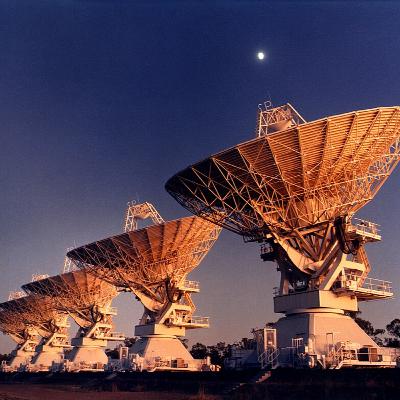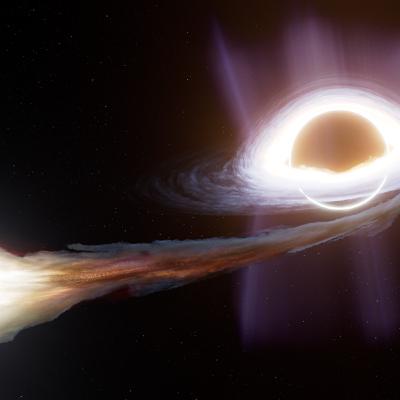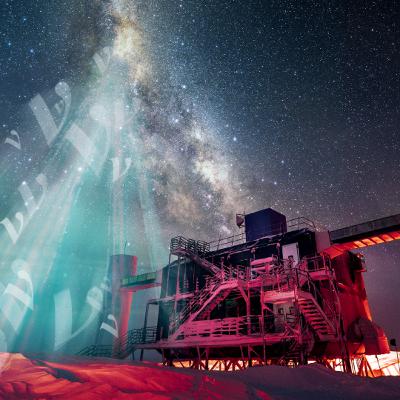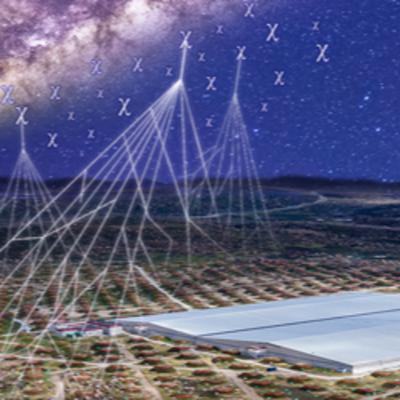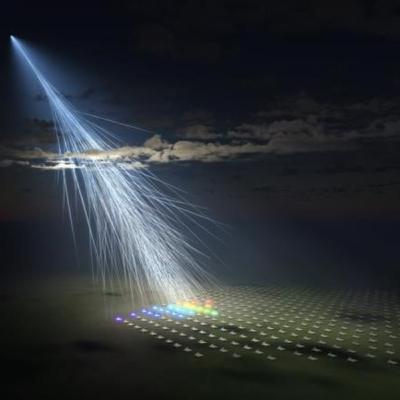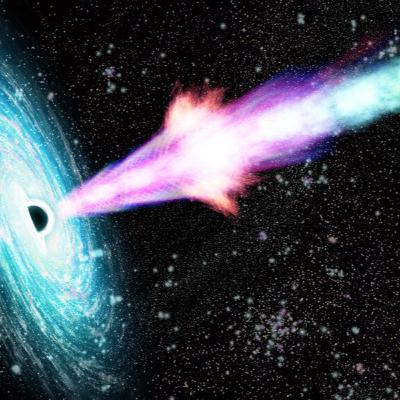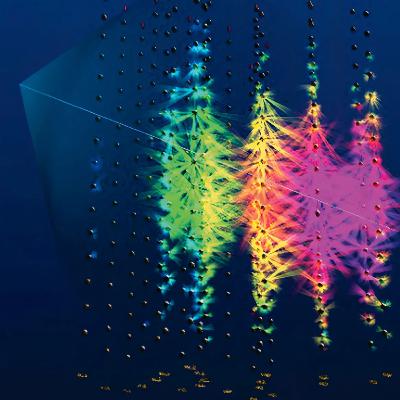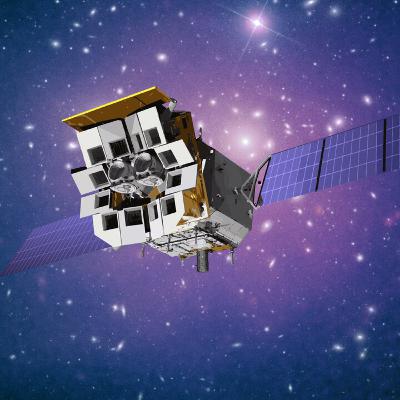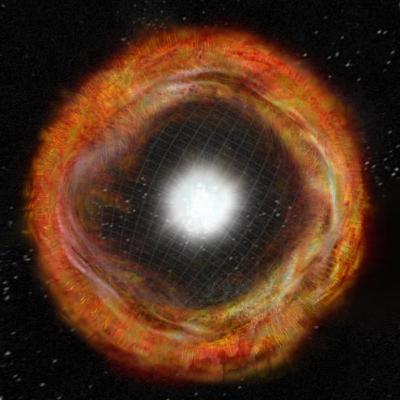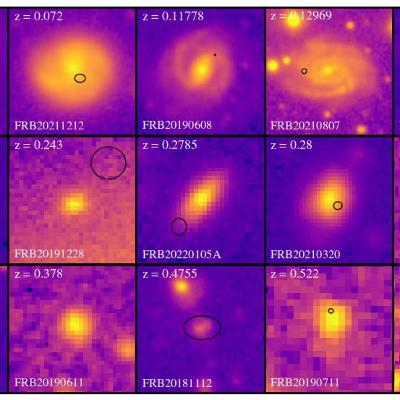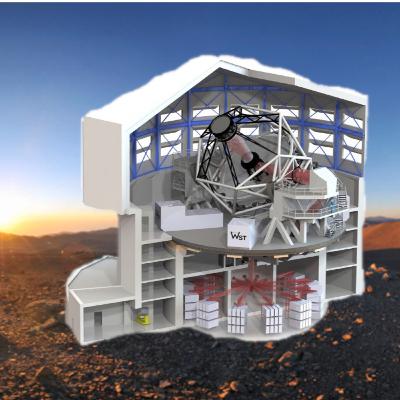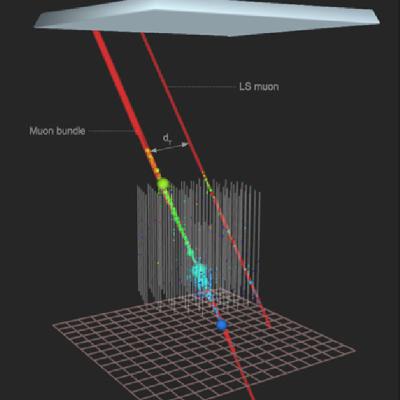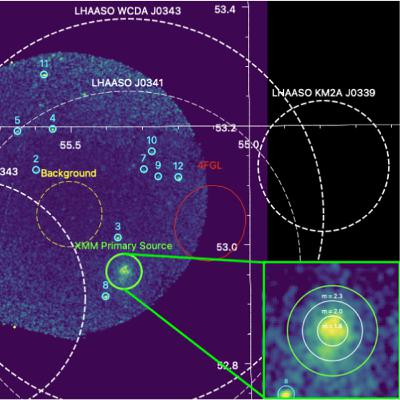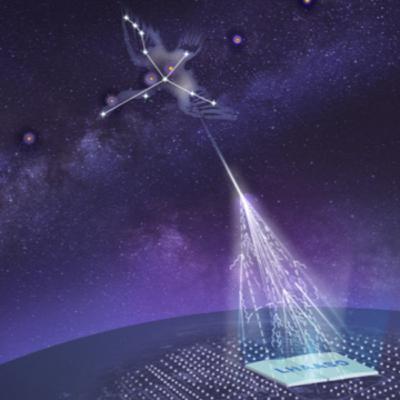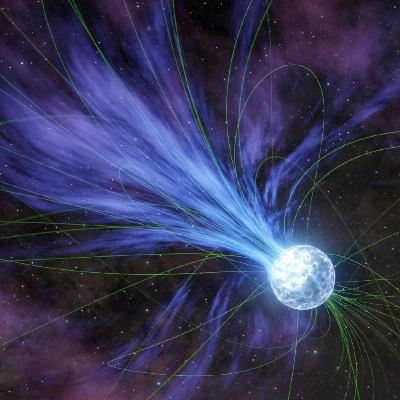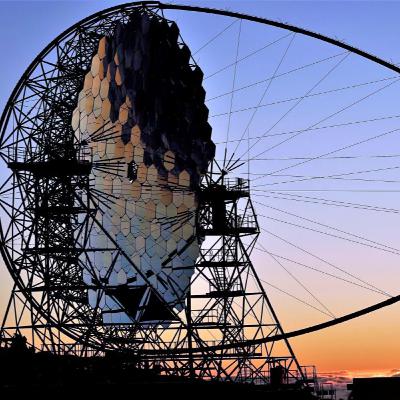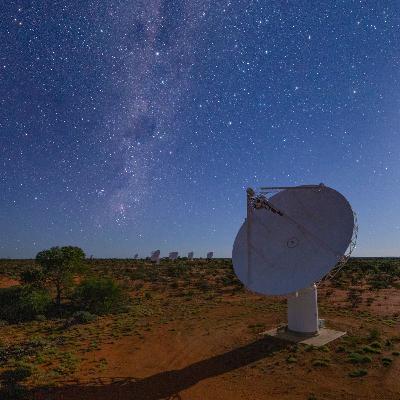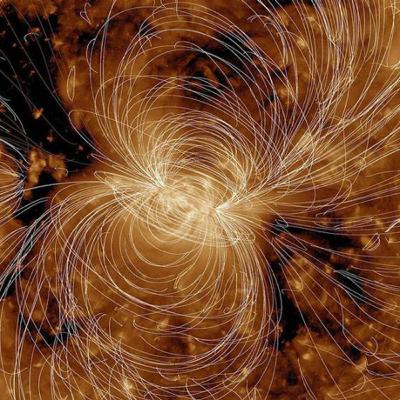Discover Multi-messenger astrophysics
Multi-messenger astrophysics

Multi-messenger astrophysics
Author: Astro-COLIBRI
Subscribed: 4Played: 17Subscribe
Share
© Astro-COLIBRI
Description
Discussions around tools and discoveries in the novel domain of multi-messenger and time domain astrophysics. We'll highlight recent publications, discuss tools to faciliate observations and generally talk about the cool science behind the most violent explosions in the universe.
65 Episodes
Reverse
This episode dives into the extraordinary 400-day observing campaign of Gamma-ray Burst (GRB) 230815A, the first major result from the Panoptic Radio View of Gamma-ray Bursts (“PanRadio GRB”) program.**The PanRadio Program**The PanRadio GRB program is a systematic, multi-year radio survey carried out on the Australia Telescope Compact Array (ATCA). Its goal is to provide comprehensive, multi-frequency (1–50 GHz), and high-cadence radio monitoring of all southern *Swift* GRB events, following their afterglow evolution from within an hour to years post-burst. Crucially, this program provides a **more unbiased view** of GRBs, targeting events like GRB 230815A that typically would not receive traditional radio follow-up because they lack known redshifts or comprehensive multi-wavelength coverage due to high line-of-sight extinction ($A_V = 2.3$).**Key Findings from GRB 230815A**GRB 230815A was a long-duration GRB, likely originating from a collapsar. The 400-day observing campaign revealed a key conflict in its behavior:* **The X-ray Afterglow:** An early X-ray jet break was observed at approximately $\sim 0.1$ days post-burst. This implies a very narrow jet opening angle, estimated to be about $2.1^\circ$.* **The Radio Afterglow:** The radio light curves, traced over an unusually long duration of 400 days, evolved approximately according to the standard self-similar expansion expected for a relativistic blast wave in a homogeneous environment. Critically, the radio evolution was **at odds** with the early X-ray break.* **The Solution: A Two-Component Jet:** Researchers reconcile this conflict by proposing a **two-component jet structure**. The early X-ray break originated from the **narrow, fast component** ($\sim 2.1^\circ$), while the delayed or absent jet break in the radio light curves stems from a separate, **wider component** with a half-opening angle estimated to be $\gtrsim 35^\circ$.**Long-Term Impact**The extensive follow-up confirmed that after 400 days, the blast wave showed no evidence of transitioning to the non-relativistic regime, which constrains the ratio between the blast wave kinetic energy and the circumburst medium (CBM) density. The PanRadio program will build a large, unbiased sample to rigorously inspect the microphysical and dynamical parameters of GRBs, revealing the true diversity of their outflows and environments.**Article Reference**These results are published in the draft article: **"First results from the PanRadio GRB Collaboration: the 400-day afterglow of GRB 230815A"**. https://arxiv.org/pdf/2511.07644Acknowledements: Podcast prepared with Google/NotebookLM. Illustration credits: CSIRO
The Search for Galactic NeutrinosThis episode explores the final results from the ANTARES neutrino telescope, which operated in the Mediterranean Sea off the coast of Toulon, France. Researchers analyzed the full, 15-year dataset (2007–2022) to search for diffuse Galactic neutrinos. These neutrinos are produced when cosmic rays (CRs) interact with interstellar matter (gas and radiation fields) in the Milky Way. Understanding this diffuse flux is key to deciphering cosmic ray transport mechanisms.Testing Theoretical ModelsThe study utilized an unbinned maximum likelihood analysis to test several phenomenological models of neutrino emission, including KRA$\gamma$ models, DiffUSE, CRINGE, and Fermi-LAT $\pi^0$. These models incorporate different assumptions about CR diffusion and source distribution. ANTARES used three data samples—one track-like and two shower-like—and its location and use of water provided superior angular resolution compared to other detectors, making it well-suited for observing the central Milky Way. Furthermore, the shower-like events extended the analysis down to the hundreds of GeV energy range.Results: Constraints and CluesWhile the ANTARES low statistics dataset did not allow for a significant discovery, the analysis placed **upper limits** on the diffuse neutrino flux that are compatible with results obtained by other experiments.Model Constraints: The results did not yield stringent constraints on the tested models. The highest observed significance was a small hint of 1.28$\sigma$ for the KRA5PeV$\gamma$ model.The Galactic Ridge Hint: Importantly, a model-independent analysis of the Galactic Ridge (|$\ell$| < 30$^\circ$ and |$b$| < 2$^\circ$) confirms a hint of a Galactic signal at 1.9$\sigma$**. This result confirms a finding from a previous ANTARES analysis.This analysis methodology, which carefully preserves the spatial-energy correlation of the templates and convolves them with detector response, is promising for testing Galactic diffuse emission models with larger future datasets, such as those from KM3NeT.Article ReferenceSearch for Diffuse Galactic Neutrinos with the Full ANTARES Telescope Dataset, ANTARES Collaboration et al. (A. Albert, S. Alves, M. André, et al.); preprint, 2511.01687Acknowledements: Podcast prepared with Google/NotebookLM. Illustration credits: CEA/Irfu
In this episode, we dive into the fascinating and violent world of galactic centers with the discovery of **AT2023uqm**, a new nuclear transient offering unprecedented insights into stellar consumption by supermassive black holes (SMBHs).AT2023uqm is only the second confirmed case of a star undergoing **repeated partial tidal disruption events (rpTDEs)**, where a star on a bound, eccentric orbit repeatedly loses its outer layers as it approaches the SMBH.**What makes AT2023uqm unique?**Unlike its predecessor, AT2023uqm exhibits a novel behavior: a nearly **exponential, or "runaway," increase in flare energy** across its series of periodic outbursts. This escalating brightness is evidence of the star’s progressive destruction over time.Key observations include:* **Periodicity:** The transient displays at least five distinct, periodic optical flares. The adopted period is **526.75 ± 0.87 days** in the observer’s frame.* **Light Curve Structure:** Each flare displays a **similar double-peaked structure**. This structure requires constraints on the progenitor star, suggesting it is either a low-mass main-sequence star or, potentially, an evolved giant star.* **Multi-wavelength Data:** Follow-up campaigns across optical/UV, X-ray, and radio bands found the optical/UV emission maintains a nearly constant blackbody temperature around 18,000 K. The spectra revealed intermediate-width Balmer lines and strong Fe II and Bowen fluorescence lines.AT2023uqm serves as a crucial framework for modeling and understanding the runaway mass loss phenomena in rpTDEs. Due to the estimated mass loss rate, scientists anticipate **only one or two more flares** before the star is completely disrupted. Be ready: the next outburst is predicted to peak (the first peak) around **August 26, 2026** (MJD 61278).**Reference:**This episode is based on the article: **"A Star’s Death by a Thousand Cuts: The Runaway Periodic Eruptions of AT2023uqm"** by Yibo Wang et al. (2025).Acknowledements: Podcast prepared with Google/NotebookLM. Illustration credits: Ralf Crawford (STScI)
Join us as we discuss the latest results from the IceCube Neutrino Observatory, utilizing 13.1 years of data, that further link high-energy neutrinos to powerful cosmic sources.### Episode Highlights* **The Extragalactic Neutrino Puzzle:** The IceCube Neutrino Observatory consistently detects a diffuse flux of high-energy cosmic neutrinos, the majority of which are extragalactic in origin. These neutrinos are expected to be produced in hadronic interactions, which also generate gamma rays.* **Revisiting NGC1068:** The Seyfert galaxy **NGC1068** remains the most significant neutrino source identified in searches across the northern sky. Notably, the observed neutrino flux from NGC1068 exceeds its gamma-ray counterpart by at least two orders of magnitude. Using $13.1$ years of data, NGC1068's emission is characterized by a soft, unbroken power-law spectrum with a spectral index $\gamma = 3.4 \pm 0.2$.* **Focusing on X-ray Bright AGN:** The X-ray bright nature of NGC1068 motivated a new search focusing on $\mathbf{47}$ X-ray bright Seyfert galaxies, selected from the Swift/BAT spectroscopic survey based on their hard X-ray fluxes (20–50 keV). This hard X-ray band is chosen because it is more robust against obscuration compared to softer X-ray bands.* **A Collective Signal:** This dedicated search revealed a significant $\mathbf{3.3\sigma}$ excess from an ensemble of $\mathbf{11}$ X-ray bright AGN (excluding NGC 1068). These results significantly strengthen the evidence that $\mathbf{X-ray}$ **bright cores of active galactic nuclei are neutrino emitters**.* **Diversity in Emission:** The population of contributing AGN includes both Seyfert I and Seyfert II galaxies, suggesting that the level of nuclear obscuration does not significantly impact the likelihood of neutrino emission. However, the individual sources show diverse characteristics: while NGC1068 exhibits a soft spectrum dominated by lower-energy events, the second most significant source, NGC7469, has an excess driven by only two very high-energy events ($E_{\nu} > 100\text{ TeV}$). This suggests that not all X-ray bright AGN share the same neutrino production mechanisms.* **The Physics Connection:** The neutrino emission is likely produced in the immediate vicinity of the supermassive black hole (SMBH), plausibly within the AGN's $\mathbf{corona}$. In this environment, coronal X-ray photons interact with high-energy protons (photomeson production), generating the 1–10 TeV neutrinos observed by IceCube.***### Reference ArticleThe data and findings discussed are presented in the research paper titled:* **"Evidence for Neutrino Emission from X-ray Bright Active Galactic Nuclei with IceCube"**.* *Draft Version Date:* October 16, 2025.Acknowledements: Podcast prepared with Google/NotebookLM. Illustration credits: IceCube, Georgia Tech
Join us as we discuss the groundbreaking discovery by the LHAASO Collaboration of a vast and unique ultra-high-energy (UHE) $\gamma$-ray source. This mysterious object, nicknamed the **"Peanut"** for its distinctive asymmetric shape, spans approximately $0.45^\circ \times 4.6^\circ$ and is located far off the Galactic plane, at a high Galactic latitude ($b \approx -17.5^\circ$), a region where UHE $\gamma$-ray sources are typically sparse.**Key Takeaways:*** **Extreme Energies Detected:** The LHAASO (Large High Altitude Air Shower Observatory) detected $\gamma$-rays in this region exceeding 100 TeV (Tera-electronvolts), with the highest-energy event reaching $760^{+60}_{-40}$ TeV. These UHE $\gamma$-rays are signatures of **extreme particle acceleration** in astrophysical sources.* **The Millisecond Pulsar Mystery:** The **highly aged millisecond pulsar (MSP) J0218+4232** is the sole candidate accelerator positionally coincident with the Peanut. The observed $\gamma$-ray luminosity ($L_{\gamma} \approx 9.36 \times 10^{32} \text{ erg s}^{-1}$) can be powered by the MSP’s spin-down power ($\dot{E} \approx 2.44 \times 10^{35} \text{ erg s}^{-1}$) if the energy conversion efficiency is greater than $0.4\%$.* **Challenging Prevailing Models:** If confirmed, this MSP association would be the **first evidence of a millisecond pulsar powering PeV particles**, directly challenging conventional models which posit that MSPs cannot sustain acceleration to PeV energies.* **Anisotropic Diffusion:** The Peanut's asymmetric, strip-like morphology is clear evidence of **anisotropic particle distribution** over a large area. Analysis suggests that particle transport plays the dominant role in shaping the Peanut structure. The resulting diffusion coefficient estimates indicate that particles travel about 400 times faster parallel to the strip than perpendicular to it ($D_{\parallel} \simeq 400 D_{\perp}$), compatible with estimates for the Galactic halo.* **Next Steps:** The definitive origin of the Peanut remains uncertain, potentially revealing a **new class of extreme Galactic accelerators** (PeVatrons). Further multiwavelength observations are necessary to constrain the mechanisms involved.**Reference Article:****"A Giant Peanut-shaped Ultra-High-Energy Gamma-Ray Emitter Off the Galactic Plane"** by The LHAASO Collaboration.Acknowledements: Podcast prepared with Google/NotebookLM. Illustration credits: LHAASO Collaboration
The origin of ultra-high-energy cosmic rays (UHECRs) has long been one of the central open questions in astroparticle physics. We dive into fascinating new research suggesting that the answer lies not in distant, powerful sources, but in **rare, stellar transients (like neutron star mergers) occurring right here in our neighboring galaxies**.**Key Takeaways:*** **Nearby Dominance:** The UHECR flux above 25 EeV is shown to be largely **dominated by just ten nearby galaxies located within 8 Mpc** of the Milky Way. This local overdensity strongly enhances the contribution of these close systems.* **Explaining Hotspots:** This nearby transient model naturally accounts for the observed anisotropies in UHECR arrival directions. A remarkable finding is that seven of the ten brightest predicted galaxies coincide with the UHECR "hotspots" reported by the Telescope Array (TA) and the Pierre Auger Observatory (Auger), an overlap with a low chance probability ($p \simeq 0.003$).* **Spectral Tension Resolved:** The model explains persistent differences in energy spectra between the Northern sky (TA) and the Southern sky (Auger). The **dominant role of the nearby Andromeda galaxy** in the Northern sky accounts for the TA spectrum being harder and extending to higher energies.* **Constraining Cosmic Magnetism:** Because the sources are nearby, the observed angular size of the UHECR hotspots reflects particle deflection in turbulent extragalactic magnetic fields (EGMF). This constraint implies an EGMF strength of approximately **1 nG**.* **Composition and Time Delays:** The transient nature of the sources means that magnetic delays stretch the arrival times of cosmic rays based on their rigidity (E/Z). This effect explains why the observed composition becomes progressively heavier at the highest energies, and why individual species dominate within narrow energy intervals.**Conclusion:**This framework offers concrete, testable predictions for future experiments like AugerPrime and TA$\times$4, including the expected skew toward heavier nuclei in the flux from nearby galaxies and the potential appearance of proton hotspots at lower energies.**Article Reference:**This research is drawn from the paper: **"Rare Transients in Nearby Galaxies Explain Ultra–high–energy Cosmic Rays"** by I. Bartos and M. Kowalski (Excerpts from arXiv:2510.06193v1).Acknowledements: Podcast prepared with Google/NotebookLM. Illustration credits: Osaka Metropolitan University/L-INSIGHT, Kyoto University/Ryuunosuke Takeshige
**GRB 250702B** is an **exceptional transient** that has puzzled astronomers, as it does not neatly fit into the expected populations of **ultra-long Gamma-Ray Bursts (GRBs)** or **relativistic Tidal Disruption Events (TDEs)**.The event produced luminous gamma-ray radiation lasting **over 25 ks** (thousands of seconds), classifying it as an ultra-long GRB. However, unlike any previously known GRB, the Einstein Probe discovered a soft X-ray "precursor" activity up to **24 hours before the main gamma-ray triggers**.Comprehensive X-ray observations using *Swift*, *NuSTAR*, and *Chandra* traced the transient’s afterglow between 0.5 and 65 days after the initial high-energy trigger. Key findings include:* **Steep X-ray Decay:** The X-ray emission decayed steeply, measured at approximately $\sim t^{-1.9}$.* **Sustained Engine Activity:** Observations showed short timescale X-ray variability (flares) in both *Swift* and *NuSTAR* data. This variability is difficult to explain via external shock emission and implies **sustained central engine activity lasting $\gtrsim 3$ days** in the observer frame.* **Afterglow Modeling:** Multi-wavelength lightcurve modeling favors the standard fireball model, suggesting the jet propagated through a **wind-like external environment**.* **Progenitor Debate:** While the event shares some properties with relativistic TDEs (such as the long-lived engine), many key characteristics, like its X-ray luminosity and short, seconds-long minimum variability timescale, are typical of standard GRBs (implying a stellar-mass black hole).* **Hybrid Scenario Favored:** The authors argue that the properties are best explained by a **"hybrid" stellar-mass black hole progenitor** system, such as a micro-TDE or a helium star merger.* **Unresolved Mystery:** The ultimate classification remains debated. Sensitive late-time X-ray monitoring is crucial to search for a **jet shutoff**, which would serve as a "smoking gun" for a TDE origin.*****Reference:**O’Connor et al. (2025). **Comprehensive X-ray Observations of the Exceptional Ultra-long X-ray and Gamma-ray Transient GRB 250702B with Swift, NuSTAR, and Chandra: Insights from the X-ray Afterglow Properties.** Draft version September 30, 2025. Acknowledements: Podcast prepared with Google/NotebookLM. Illustration credits: University of Bath
This week, we dive into the cosmic puzzle posed by ultra-high-energy (UHE) neutrinos. The conversation centers on the **KM3-230213A event**, detected by the KM3NeT/ARCA detector, which is the **highest-energy neutrino observed to date**, estimated at $220^{+570}_{-110}$ PeV. This detection marks the first observation of a presumed astrophysical neutrino in the UHE regime.We explore the longstanding candidates for these UHE neutrinos: **Gamma-Ray Bursts (GRBs)**. GRBs are the most energetic transient events observed and are theorized to produce high-energy neutrinos when their powerful blastwaves interact with the surrounding matter and radiation fields.The study uses the KM3-230213A event, combined with the non-detections from IceCube and Pierre Auger, to constrain the relevant model parameters of long-duration GRBs (lGRBs).**Key Takeaways:** Researchers investigated two primary models for GRB blastwaves: expanding in a constant density **Interstellar Medium (ISM)** or developing in a **wind-like environment (WIND)** with radially decreasing density.The study derived constraints on **baryon loading** ($f_b$), which is the ratio of energy between protons and electrons.For the **ISM model**, the baryon loading is constrained, for example, to $f_b \le 392$ at 90% confidence level if the interstellar medium particle density is $1 \text{ cm}^{-3}$. For $3 \text{ cm}^{-3}$, $f_b \le 131$.For the **WIND model**, constraints on $f_b$ vary, such as $f_b \le 50$ at 90% confidence for a density parameter $A^* = 0.06$.The results demonstrate that a large population of lGRBs evolving in blastwaves **can give rise to the diffuse UHE neutrino flux associated with KM3-230213A**. Furthermore, because GRBs are transient sources, they evade the strong constraints placed on steady neutrino sources (like blazars/AGN) by measurements of the diffuse gamma-ray sky.**Reference to the Article:**The findings discussed are based on the paper: **"Constraining gamma-ray burst parameters with the first ultra-high energy neutrino event KM3-230213A"** by The KM3NeT Collaboration. (Preprint reference: 2509.14895v1.pdf).Acknowledements: Podcast prepared with Google/NotebookLM. Illustration credits: KM3NeT Collaboration
his episode dives into the groundbreaking discoveries of the Einstein Probe, a new soft X-ray mission revolutionizing our understanding of high-energy transients in the universe.The Einstein Probe (EP), launched on January 9, 2024, has opened a new era of transient discovery in the previously largely unexplored soft X-ray band. It detects numerous fast X-ray transients, many of which surprisingly show no gamma-ray emission, making their connection to more common gamma-ray bursts (GRBs) a key mystery.Recent research, detailed in the article "The redshift distribution of Einstein Probe transients supports their relation to gamma-ray bursts," has made a significant breakthrough. Using the Astro-COLIBRI archive of transient phenomena and analyzing the redshift distributions of both EP fast X-ray transients and long-duration gamma-ray bursts, scientists found **no statistically significant difference** between them. This strong empirical connection suggests that their redshifts are drawn from the same underlying distribution and that most extragalactic EP transients are **closely related to long GRBs**, originating from the deaths of massive stars (collapsars).Further supporting this link is the agreement of EP transients with the "Amati relation," a known correlation between spectral peak energy and isotropic-equivalent energy for GRBs. Unlike long GRBs, EP transients are **clearly distinct from short-duration GRBs**, which originate from compact object mergers.The Einstein Probe is effectively **uncovering a "missing population"** of "failed jets" and "dirty fireballs" that primarily emit at soft X-ray wavelengths. These include fascinating new discoveries such as relativistic shock breakout candidates and even a candidate relativistic jetted tidal disruption event. The volumetric rates of these EP transients are estimated to be comparable to or even exceed those of standard GRBs, suggesting that weak or failed jets might be intrinsically more common than successful ones.This work highlights the crucial role of the Einstein Probe in expanding our knowledge of **massive star deaths and the mechanisms of jet formation**, revealing a parameter space of cosmic explosions previously hidden from gamma-ray-only detectors.**Read the full article:**O’Connor, B. et al. "The redshift distribution of Einstein Probe transients supports their relation to gamma-ray bursts." Draft version September 10, 2025.Acknowledements: Podcast prepared with Google/NotebookLM. Illustration credits: ESA
Join us as we explore the groundbreaking observations of **GRB231117A**, a short gamma-ray burst (SGRB) located at a redshift of z = 0.257. This event, detected by the Neil Gehrels Swift Observatory, was quickly followed up by the Australia Telescope Compact Array (ATCA) just 1.3 hours post-burst, providing **unprecedented early radio detection**.**In this episode, we discuss:*** **Early Radio Afterglow:** How ATCA's rapid response revealed a dynamic early radio afterglow with **flaring, scintillating, and plateau phases**.* **Cosmic Scintillation:** The fascinating phenomenon of interstellar scintillation, which allowed scientists to place the **earliest upper limit on a GRB blast wave size to date**, constraining it to less than 1 × 10^16 cm within 10 hours of the burst.* **Energy Injection Unveiled:** Multi-wavelength modeling of GRB231117A's afterglow revealed a period of **significant energy injection** occurring between approximately 0.02 and 1 day post-burst.* **The Violent Collision Hypothesis:** This energy injection is best explained by a **violent collision of two relativistic shells**. We delve into how a **reverse shock** propagating through the injection shell accounts for the early radio plateau, while an observed **X-ray flare** is consistent with a shock passing through the leading impulsive shell.* **Late-Time Evolution:** Beyond the initial energy injection, the blast wave transitioned to a **classic decelerating forward shock**, exhibiting an electron distribution index of p = 1.66 ± 0.01 and a jet-break around 2 days. The final collimation-corrected energy was calculated to be approximately 5.7×10^49 erg, about **18 times the initial impulsive energy**.* **Probing Central Engines:** This study highlights the **critical importance of rapid and sensitive radio follow-up** for exploring the complex behavior of GRB central engines and their relativistic outflows.This deep dive into GRB231117A offers direct insight into the powerful mechanisms behind these cosmic explosions and paves the way for future discoveries with next-generation radio telescopes.**Article Reference:**Anderson, G. E., Lamb, G. P., Gompertz, B. P., et al. (2025). The radio flare and multi-wavelength afterglow of the short GRB231117A: energy injection from a violent shell collision. *Draft version August 21, 2025*, arXiv:2508.14650v1.Acknowledements: Podcast prepared with Google/NotebookLM. Illustration credits: Nancy Atkinson
Join us as we explore the latest research into Fast Radio Bursts (FRBs), mysterious, intense pulses of radio emission lasting only milliseconds. These cosmic phenomena are not just fleeting signals; they are powerful probes of the ionized gas across the universe and valuable tools for cosmological studies. In this episode, we delve into an investigation of FRB properties and their host galaxies, aiming to understand how the environment surrounding an FRB influences its observed characteristics.What we discuss:• The Phenomenon of Scattering: Learn how FRBs' paths through ionized media cause "scattering," a frequency-dependent broadening of their pulse profiles. This scattering is thought to primarily originate within their host galaxies.• Key Correlations Found with FRB Scattering: ◦ Compactness and Stellar Surface Density: The study found a highly significant positive correlation between an FRB's scattering timescale (τ) and the stellar surface density (or compactness) of its host galaxy. This suggests that more compact (denser) host galaxies may contain more ionized content, leading to greater scattering of the FRB signal. ◦ Mass-Weighted Age: A highly significant positive correlation was also found between scattering timescale and the mass-weighted age of stars in the host galaxy. This implies that older stellar populations might contribute to increased scattering, though it's not driven by the overall galaxy mass. ◦ Gas-Phase Metallicity: There's a weakly significant positive correlation between scattering timescale and the gas-phase metallicity. Higher metallicity gas could mean more ionizing photons and electrons within the galaxy, contributing to scattering. This might be connected to compactness and mass-weighted age, as these properties can also correlate with metallicity.• Surprising Absences of Correlation for Scattering: ◦ The study found no correlation between FRB scattering and host galaxy stellar mass or star formation rate. ◦ Crucially, there was no correlation found with the galaxy's inclination angle or optical disc axis ratio (b/a) for scattering. This finding challenges previous suggestions of an inclination bias in FRB detection.• Rotation Measure and Galaxy Orientation: ◦ A strong anti-correlation was identified between the absolute Faraday rotation measure (|RMex|) of an FRB and the optical disc axis ratio (b/a) of its host galaxy. This means that FRBs from more edge-on galaxies tend to exhibit greater rotation measures, likely because the signal travels through a larger amount of the galaxy's magnetic field. ◦ The absence of other strong correlations for RM suggests the immediate environment of the FRB progenitor might play a significant role in determining RM, but the host galaxy's orientation is still important.• Polarization Insights: ◦ While some weak correlations were seen for circular polarization fractions, these were often driven by single outlier datapoints and are not considered broadly significant across the sample. No strongly significant correlations were found for linear polarization.• The Modest Sample Size: The researchers emphasize that while several correlations are statistically robust, the sample size is still relatively modest. Further high-time resolution FRB detections and detailed host galaxy follow-up are essential to confirm these initial findings.Source Article:• Glowacki, M., Bera, A., James, C. W., et al. (2020). An investigation into correlations between FRB and host galaxy properties. Cambridge Large Two, 1–21.Acknowledements: Podcast prepared with Google/NotebookLM. Illustration credits: ICRAR
Join us as we explore the groundbreaking discovery of FRB 20240304B, the most distant Fast Radio Burst (FRB) ever detected, offering unprecedented insights into the early universe.In this episode, we discuss:• What are Fast Radio Bursts (FRBs)? These enigmatic, millisecond-duration radio signals provide unique information about the plasma permeating our universe, revealing details about magnetic fields and gas distributions.• The Record-Breaking Discovery: FRB 20240304B was detected by the MeerKAT radio telescope and precisely localized to a host galaxy using the James Webb Space Telescope (JWST).• A Journey Back in Time: This FRB originates at a redshift of 2.148 ± 0.001, meaning it occurred just 3 billion years after the Big Bang. This discovery doubles the redshift reach of localized FRBs and marks the first FRB detected at "cosmic noon," a peak era of galaxy formation.• The Host Galaxy's Secrets: FRB 20240304B was traced to a low-mass, clumpy, star-forming galaxy with low metallicity, estimated to be very young with a stellar formation timescale of around 51.7 million years. This makes it atypical compared to previously observed FRB host galaxies.• Unveiling the Progenitor: The host galaxy's properties – its low stellar mass, active star formation, and low metallicity – strongly favor short-delay time progenitor models, such as those involving young magnetars born in supernovae. This supports the idea that FRB birth rates could trace the cosmic star-formation history.• Probing the Cosmic Web: The sightline of FRB 20240304B intersects cosmic structures like the Virgo Cluster and a foreground galaxy group, revealing complex magnetic field environments over vast scales. These structures contribute significantly to the FRB's dispersion measure (DM).• A Critical Milestone: This detection highlights the power of FRBs as cosmological probes, allowing astronomers to trace the distribution of ionized matter and gain insights into galaxy evolution during the universe's most active era. MeerKAT's unique sensitivity was crucial, demonstrating its capability to explore the z > 2 universe.Reference: Caleb, M., Nanayakkara, T., Stappers, B., et al. (2024). A fast radio burst from the first 3 billion years of the Universe. Excerpts from "2508.01648v1_FRB20240304B.pdf".Acknowledements: Podcast prepared with Google/NotebookLM. Illustration credits: Danielle Futselaar for MeerTRAP
In this episode, we dive into the exciting future of **multi-messenger astronomy**, specifically focusing on the detection and characterization of binary neutron star (BNS) mergers.* **The Dawn of Multi-Messenger Astrophysics:** Our understanding of cosmic events was revolutionized by the extraordinary joint detection of gravitational waves (GWs) and light from a BNS merger on August 17, 2017 (GW170817). This single event confirmed theoretical hypotheses about short gamma-ray bursts (SGRBs) originating from BNS mergers and provided insights into kilonovae (KNe) – the thermal radiation powered by radioactive decay of heavy elements.* **Next-Generation Observatories:** The upcoming third-generation GW observatories, such as the **Einstein Telescope (ET)** and **Cosmic Explorer (CE)**, are poised to dramatically increase detection rates, potentially observing hundreds of thousands of BNS mergers annually, reaching distances beyond redshift (z) ~ 3.* **The Wide-field Spectroscopic Telescope (WST):** This proposed 12-meter-class spectroscopic facility, expected to operate in the 2040s in the southern hemisphere, will be crucial for exploiting the unique information from joint GW and electromagnetic (EM) detections. WST will employ both **Integral Field Spectroscopy (IFS)** and **Multi-Object Spectroscopy (MOS)**, enabling simultaneous acquisition of multiple spectra over wide fields of view.* **Detecting Faint Counterparts:** * WST is designed to detect **Kilonovae (KNe)** up to **z ~ 0.4** and apparent magnitudes as faint as **mAB ~ 25 (with fibres) to ~25.5 (with IFS)**. The optimal time for KN detection observations is **12–24 hours after the merger**. * **GRB afterglows** can be observed at even higher redshifts, beyond z = 1, particularly for on-axis or slightly off-axis systems (viewing angles Θview ≲ 15°). Timely follow-up, within a few hours of the GRB prompt detection, is critical due to their rapid decay.* **Observing Strategies and Challenges:** * The vast majority of next-generation GW events will have **large sky localization regions** and **faint EM counterparts**, making their identification challenging. * **Galaxy-targeted searches** with WST involve identifying galaxies within the 3D error volume of the GW signal, leveraging high multiplexing capabilities. These searches benefit greatly from complete galaxy catalogues with redshift information up to z ≤ 0.5. * **Synergy with photometric surveys**, like the Vera Rubin Observatory, allows WST to target transient candidates identified by these wide-field facilities. * **The "Golden Events"**: BNS mergers detected by ET+CE at z < 0.3 (or ET-alone at z < 0.2) with sky localizations better than 10 deg² are ideal for WST, as it can cover all galaxies in the error volume with limited exposures (e.g., 3 one-hour exposures for 10 deg² or 1 one-hour exposure for 1 deg²).* **Addressing Offsets and Host Galaxies:** Many EM counterparts are not expected to be at the exact center of their host galaxies. The use of **mini-IFUs or "fibre bundles"** is proposed as an extremely valuable solution to cover regions around host galaxy centers and detect counterparts with larger offsets. Spectral subtraction techniques can also be used to separate the transient's spectrum from the host galaxy's.* **The Future is Multi-Messenger:** This research underscores the need for **new instruments** that are developed with multi-messenger science as a core design case, enabling rapid data reduction and analysis for timely alerts to the astronomical community.**Reference:**Bisero, S., Vergani, S. D., Loffredo, E., et al. (2025). Multi-messenger observations of binary neutron star mergers: synergies between the next generation gravitational wave interferometers and wide-field, high-multiplex spectroscopic facilities. *Astronomy & Astrophysics*.Acknowledements: Podcast prepared with Google/NotebookLM. Illustration credits: ESO
Dive into the fascinating world of cosmic rays with the latest research from the IceCube Neutrino Observatory! This episode explores new measurements of high-energy muons in extensive air showers, shedding light on the mysterious mass composition of cosmic rays and the challenges of simulating their interactions in Earth's atmosphere.**What we discuss:*** **Measuring High-Energy Muons:** Learn about the first measurement of the **mean number of muons with energies above 500 GeV** in near-vertical extensive air showers. These "TeV muons" are crucial because they originate predominantly in the early stages of shower development and their number depends strongly on the energy and mass of the primary cosmic ray.* **The IceCube Neutrino Observatory's Unique Capabilities:** Discover how this research uses a **coincident detection method** combining IceTop, the surface detector array, with the large-volume in-ice detector located 1.5 km to 2.5 km below the surface. The thick ice absorbs lower-energy muons, allowing for a pure measurement of high-energy muons.* **Cosmic Ray Energies and Hadronic Models:** The study focuses on cosmic rays with primary energies between **2.5 PeV and 100 PeV**. The results were analyzed using various hadronic interaction models, including **Sibyll 2.1, QGSJet-II.04, and EPOS-LHC**, which are vital for simulating air shower development.* **The "Muon Puzzle" and Inconsistencies:** We'll explore the intriguing **"Muon Puzzle,"** a known discrepancy between measurements and simulations of muons in air showers. This new study compares high-energy (TeV) muon measurements with previous low-energy (GeV) muon measurements from IceTop alone. While Sibyll 2.1 shows excellent agreement between the two measurements, **the EPOS-LHC model reveals a significant tension**, indicating it doesn't consistently describe both low and high-energy muon data.* **Implications for Particle Physics and Astronomy:** Understanding these hadronic interactions is crucial for inferring cosmic-ray mass composition, calculating atmospheric neutrino flux, and exploring particle physics beyond human-made accelerators. Solving the Muon Puzzle is considered one of the most pressing problems in high-energy cosmic-ray physics.**Article Reference:**"Measurement of the mean number of muons with energies above 500 GeV in air showers detected with the IceCube Neutrino Observatory" by R. Abbasi et al. (IceCube Collaboration). Dated June 25, 2025.Acknowledements: Podcast prepared with Google/NotebookLM. Illustration credits: D. Soldin
Join us as we dive into the latest astronomical discovery! Scientists have identified a **new candidate pulsar wind nebula (PWN)**, named XMMU 034124.2+525720, which may be directly linked to **1LHAASO J0343+5254u**, a powerful "PeVatron" in our galaxy.**What are PeVatrons?** They are the most energetic astrophysical objects in our galaxy, producing cosmic rays (CRs) with energies exceeding 1 PeV (10^15 eV), far surpassing what terrestrial accelerators can achieve. Understanding them is key to solving the mystery of the most energetic galactic cosmic rays and gamma rays.This potential PWN, discovered through extensive **XMM-Newton observations**, exhibits key characteristics typical of other very high-energy PWNs like the "Eel" and "Boomerang" nebulae. Its X-ray emission shows an **extended, asymmetric morphology** and a **power-law spectrum (ΓX = 1.9)** that becomes notably softer farther from its center.Using **multiwavelength modeling**, researchers demonstrated that a **fully leptonic model**—involving electron synchrotron radiation and inverse-Compton (IC) scattering of ambient photons—can explain the observed X-ray and gamma-ray emission, especially if there are **elevated infrared (IR) photon fields** in the region. While this model largely accounts for the LHAASO gamma-ray flux, future observations will help explore if hadronic processes in nearby molecular clouds also contribute to the gamma-ray emission and potential neutrino flux.Though XMM-Newton observations didn't definitively resolve a central pulsar or detect X-ray pulsations, this discovery marks a crucial step in understanding galactic PeVatrons. Future, higher-resolution X-ray observations with missions like Chandra and NuSTAR, along with dedicated radio searches for a pulsar, are planned to solidify this PWN classification and provide deeper insights into these extreme cosmic accelerators.**Article Reference:**DiKerby, S., Zhang, S., Ergin, T., et al. 2025, *Discovery of a Pulsar Wind Nebula Candidate Associated with the Galactic PeVatron 1LHAASOJ0343+5254u*, The Astrophysical Journal, 983:21.Acknowledements: Podcast prepared with Google/NotebookLM. Illustration credits: Stephen DiKerby et al., 2025 ApJ 983 21
In this episode, we dive into a fascinating new study that performs the **first direct consistency check** between two crucial measurements from the Large High Altitude Air Shower Observatory (LHAASO): the **cosmic-ray (CR) proton spectrum at the "knee"** and the **Galactic diffuse gamma-ray emission**.The "knee" in the cosmic ray spectrum (around a few PeV) is thought to mark the maximum energy reached by Galactic CR accelerators. Diffuse gamma-ray emission, primarily from CR interactions with interstellar gas, provides a complementary view of the same underlying particle population.The study reveals a **persistent mismatch**:* The **predicted gamma-ray flux robustly overshoots the LHAASO data** in both inner and lateral Galactic regions.* This discrepancy is evident in **both normalization and spectral shape**.* This is particularly puzzling because while an excess of gamma-rays has been discussed before, **evidence of a deficit in observed emission represents a new and more puzzling feature**.Key insights from the research:* The disagreement **challenges conventional scenarios** linking the local cosmic-ray sea to Galactic gamma-ray emission.* It **calls for a revision of current cosmic ray models** in the TeV-PeV sky.* The mismatch is **not attributed to the hadronic interaction model** used for calculations; using alternative models would actually increase the tension.* The findings suggest a **possible tension between the LHAASO gamma-ray observations and the CR proton flux measured by LHAASO itself**.* One intriguing explanation is that the **CR spectrum measured locally might not be the same as the one responsible for the observed gamma-ray emission** throughout the Galaxy, possibly having a different "knee" location (e.g., around 300 TeV).* Uncertainties also exist due to the **lack of helium flux measurements** between 100 TeV and a few PeV.This research highlights the critical importance of evaluating the consistency between these two types of measurements and opens new avenues for understanding cosmic ray propagation in our Galaxy.**Article Reference:**Espinosa Castro, L. E., Villante, F. L., Vecchiotti, V., Evoli, C., & Pagliaroli, G. (2025). *LHAASO Protons versus LHAASO Diffuse Gamma Rays: A Consistency Check*. arXiv preprint arXiv:2506.06593.Acknowledements: Podcast prepared with Google/NotebookLM. Illustration credits: LHAASO
In this episode, we dive into the mysterious world of Fast Radio Bursts (FRBs) and the ongoing quest to understand their origins. We discuss a systematic search for **past supernovae (SNe) and other historical optical transients** at the positions of FRB sources, exploring a leading theory that links FRBs to **magnetars**.The study **found no statistically significant associations** within the 5σ FRB localization uncertainties between the observed CHIME-KKO or literature FRBs and optical transients, *except* for a previously identified potential optical counterpart to FRB 20180916B, named AT 2020hur. AT 2020hur, however, occurred *after* the FRB was first detected, making it inconsistent with the "past SN" progenitor model, though it remains a potential association under other theories.**Chance Coincidences:** The probability of a chance coincidence (Pcc) between an FRB and a transient was found to be **low (Pcc < 0.1)**. It's estimated that it would take **~22,700 subarcsecond-localized FRBs** to yield one chance association, which translates to roughly **30–60 years** at the projected CHIME/FRB Outrigger detection rate. This means that any robust match found in the near future is highly likely to be a **physical association**.**Implications of Transparency Time:** The research estimates that **5–7% of matched optical transients** (if all were SNe) are old enough to be associated with a detectable FRB, assuming the 6.4-10 year transparency timescale. More broadly, **23–30% of all cataloged SNe and 32–41% of CCSNe** are currently old enough to have detectable FRB emission.**The Future with Rubin Observatory:** The upcoming **Vera C. Rubin Observatory (LSST)** is expected to dramatically increase the number of known SNe and the volume over which they can be detected. This will significantly **increase the rate of potential FRB-SN associations** at redshifts below z~1, where most FRBs are discovered.**Flexible Framework:** The systematic search machinery developed for this work is publicly available and flexible, allowing it to be applied to a wide range of transient timescales, FRB localization sizes, and different optical transient populations in future searches.**Reference Article:*** DONG, Y., KILPATRICK, C. D., FONG, W., et al. (2025). **Searching for Historical Extragalactic Optical Transients Associated with Fast Radio Bursts**. arXiv e-prints, arXiv:2506.06420v1.Acknowledements: Podcast prepared with Google/NotebookLM. Illustration credits: NASA - JPL/Caltech
In this episode, we discuss a significant new detection of the Geminga pulsar, a middle-aged, radio-quiet gamma-ray pulsar. The **Large-Sized Telescope (LST-1)**, the first of the Cherenkov Telescope Array Observatory (CTAO) Northern Array, has detected Geminga at energies down to 20 GeV.Key takeaways from the study:* The LST-1 detected the Geminga pulsar using 60 hours of data.* The **second emission peak (P2)** of Geminga was detected with a high significance of **12.2σ** in the energy range between 20 and 65 GeV. This is a doubled significance compared to previous results by the MAGIC Collaboration, achieved with less observation time and a single telescope.* The first peak (P1) was detected at a lower significance level of 2.6σ.* The LST-1 analysis has an estimated energy threshold as low as 10 GeV for pulsar analysis, although the peak in reconstructed energy was around 20 GeV.* The best-fit model for the P2 spectrum was a power law with a spectral index of Γ = 4.5 ± 0.4 (statistical uncertainty). When considering systematic uncertainties, the spectral index is Γ = (4.5 ± 0.4stat)+0.2sys −0.6sys. This is compatible with previous results from the MAGIC Collaboration.* A joint fit of LST-1 and Fermi-LAT data preferred a power law with a sub-exponential cut-off (PLSEC) over a pure exponential cut-off (PLEC), although the PLSEC model didn't fully match the LST-1 points.* While no curvature was detected in the LST-1-only spectrum, combining LST-1 and Fermi-LAT data showed a statistical preference for a curved log parabola model at lower minimum energies (10-20 GeV).* Theoretical models, such as the synchro-curvature (SC) model from Harding et al. (2021), can explain the dominance of the SC component at high energies and the non-detection of the first peak above 20 GeV, although improvements are needed to match the LST-1 SED better.* These results demonstrate the LST-1's excellent capabilities for observing pulsars at the upper end of their spectra and its overlap with the Fermi-LAT energy range. Future observations with the full CTAO Northern Array are expected to improve sensitivity and allow for more detailed studies of the pulsar peaks and spectra.**Reference:*** K. Abe et al. (CTAO LST Project). Detection of the Geminga pulsar at energies down to 20 GeV with the LST-1 of CTAO. *Astronomy & Astrophysics* manuscript no. aa54350-25 ©ESO 2025 May 29, 2025.Acknowledements: Podcast prepared with Google/NotebookLM. Illustration credits: Iván Jiménez (IAC)
Astronomers have made a significant discovery, detecting X-ray emission from a rare type of cosmic object known as a **Long-Period Radio Transient (LPT)** for the very first time.The object, designated **ASKAP J1832−0911**, is extraordinarily bright in radio, reaching flux densities of 10–20 Jy.Crucially, it exhibits **coincident radio and X-ray emission**, both pulsing with a regular period of **44.2 minutes** (2,656.2412 seconds in radio, 2,634 seconds in X-rays). This combination of properties – long period, bright coherent radio, and variable X-ray emission – makes ASKAP J1832−0911 **unlike any other known object in our galaxy**. Its luminosity is **highly variable**, with both radio and X-ray emission decreasing dramatically over a few months following a 'hyper-active' phase. This variability suggests that the lack of previous X-ray detections from other LPTs might be due to not observing them during such brief bright phases. The object is estimated to be located at a distance of approximately **4.5 kpc**. Current data suggest potential classifications like an old magnetar or an ultra-magnetized white dwarf, though both interpretations present **theoretical challenges** for existing models. It is not consistent with a classical rotation-powered pulsar or a typical isolated white dwarf.The discovery of X-ray emission from ASKAP J1832−0911 demonstrates that LPTs can be **more energetic** than previously believed. It also establishes a new class of hour-scale periodic X-ray transients linked to exceptionally bright radio emission.Reference Article: "Detection of X-ray emission from a bright long-period radio transient" by Ziteng Wang et al..Acknowledements: Podcast prepared with Google/NotebookLM. Illustration credits: Alex Cherney
A recent study utilized **15 years of observations** from the **Fermi Large Area Telescope (LAT)** to analyze the gamma-ray emission from the Sun in its quiet state, meaning when it's not flaring. This is the first study to separately analyze the flux variation of the two distinct components of this quiet-state gamma-ray emission over solar cycles.According to theoretical understanding, the Sun's steady-state gamma-ray emission arises from interactions with Galactic cosmic rays (CRs). There are two main components:* The hadronic component, which is primarily confined to the **solar disk**. It's thought to be produced by CR cascades in the solar atmosphere. This component's flux is expected to **anticorrelate with solar activity** (like sunspot number, SSN) and **correlate with the flux of cosmic rays**.* The **leptonic component**, which is spatially **extended** beyond the solar disk. This is theorized to be an Inverse Compton (IC) component, where CR electrons scatter off solar photons. Like the disk component, its intensity was expected to **vary with the solar cycle**, being highest during solar minimum and lowest during solar maximum, thus anticorrelating with SSN and correlating with CR flux (specifically CR electron flux).Previous Fermi-LAT observations had shown that the overall solar gamma-ray flux varies with solar activity, anticorrelating with SSN and changing by nearly a factor of two between solar maximum and minimum. However, these studies had not separated the contributions of the disk and extended components.This new work analyzed Fermi-LAT data from August 2008 to June 2023, carefully selecting data and using an "off-source" method to evaluate background contamination. They were able to distinguish the two components and study their flux variations over Solar Cycle 24 and the beginning of Cycle 25.The key findings from this analysis reveal both confirmation of expectations and **significant surprises**:* For the **disk component**, the results align well with theoretical predictions. Its flux variation: * **Anticorrelates strongly with the sunspot number (SSN)**. * **Correlates strongly with the flux of cosmic-ray protons** measured near Earth. * Correlates with the gamma-ray flux from the Moon, supporting similar production mechanisms. * The variation is **independent of energy** above 250 MeV. This confirms that the hadronic emission mechanism for the disk component has been correctly identified.* For the **spatially extended component**, the behavior was **unexpectedly complex**. * It showed the expected anticorrelation with SSN and correlation with the disk component **only until approximately mid-2012**. * **After 2013, there was no longer any significant correlation or anticorrelation observed** between the extended component's flux variation and either the SSN or the cosmic-ray electron flux. Correlation coefficients over the entire period are below 0.3. * Like the disk component, the extended component's variation was also found to be independent of energy above 250 MeV.This **surprising lack of correlation for the extended component after 2013** is a major finding. The change in behavior coincides with the start of the **reversal of the Sun's polar magnetic field**, which began at the end of 2012. This suggests that the transport and modulation of cosmic rays, particularly electrons, in the **inner heliosphere (close to the Sun)** may be **unexpectedly complex** and possibly different for electrons and protons.Paper: https://arxiv.org/abs/2505.06348Acknowledements: Podcast prepared with Google/NotebookLM. Illustration credits: Solar Dynamics Observatory/GSFC/NASA


